Physical Address
304 North Cardinal St.
Dorchester Center, MA 02124
Physical Address
304 North Cardinal St.
Dorchester Center, MA 02124
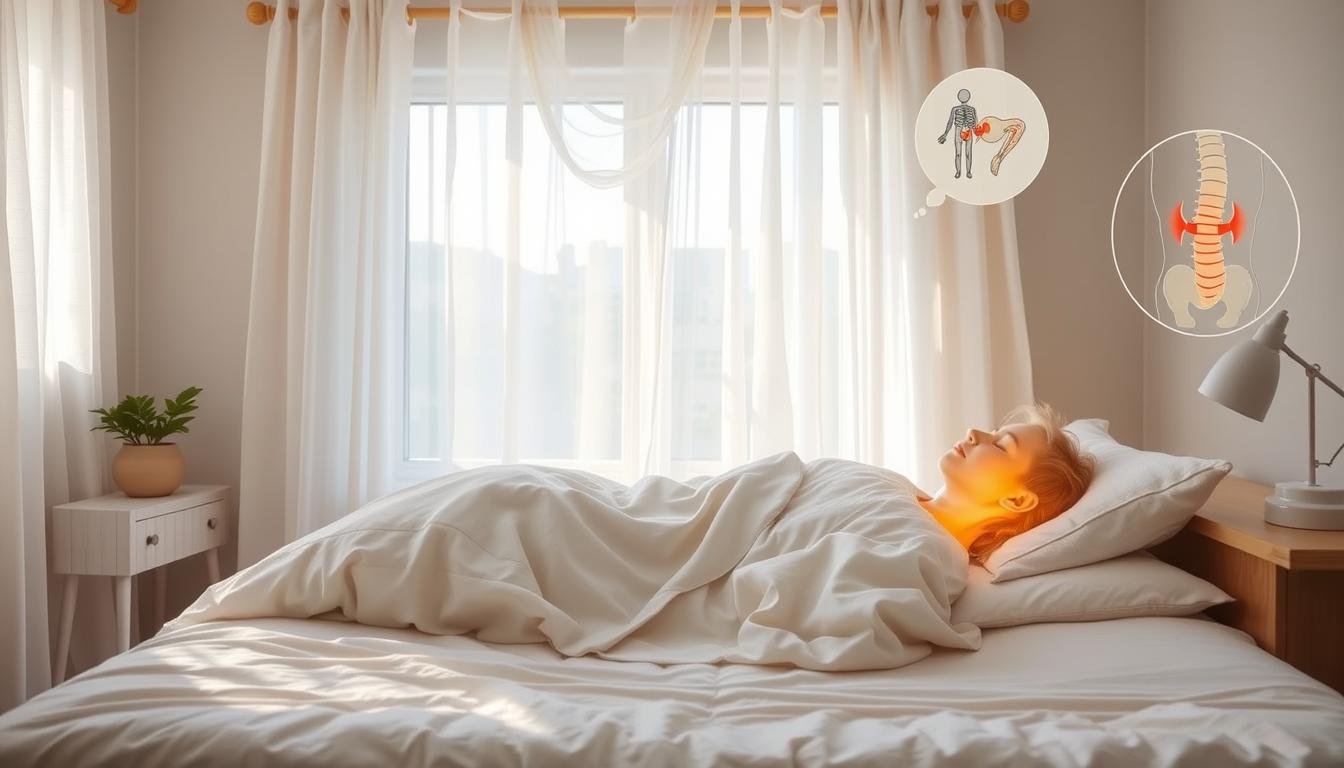
If you’ve ever woken up with discomfort radiating from your lower back or hips, you may understand how profoundly our sleeping positions impact our overall comfort and well-being. For those suffering from sacroiliac joint pain, finding the right ergonomic sleeping posture is not just a matter of preference—it’s essential for alleviating pain and promoting healing.
By adopting an anti-inflammatory sleeping position, you can create a more supportive environment for your hips and spine, ultimately aiding in hip pain management. In this article, we will explore various sleeping positions designed to provide relief and foster a restorative night’s sleep, helping you wake up refreshed and without discomfort.
Finding the best sleeping position for sacroiliac joint pain can greatly help manage discomfort and improve your quality of sleep2.

Tight hip flexors can make SI joint pain worse by causing irritation and discomfort1. It’s key to use ergonomic sleeping postures that support spinal alignment and reduce pressure on the SI joints. This is crucial for lower back pain relief and managing hip pain. Research shows chiropractic adjustments can help with SI joint pain relief in three to four weeks2.
Sacroiliac joint pain, also known as sacroiliitis or pelvic girdle pain, is a common cause of lower back discomfort. It affects the sacroiliac joints, which connect the base of the spine to the pelvis. This pain is responsible for about 13% of chronic low back pain cases3. Another study shows that 15-30% of lower back pain cases come from SI joint injury3.
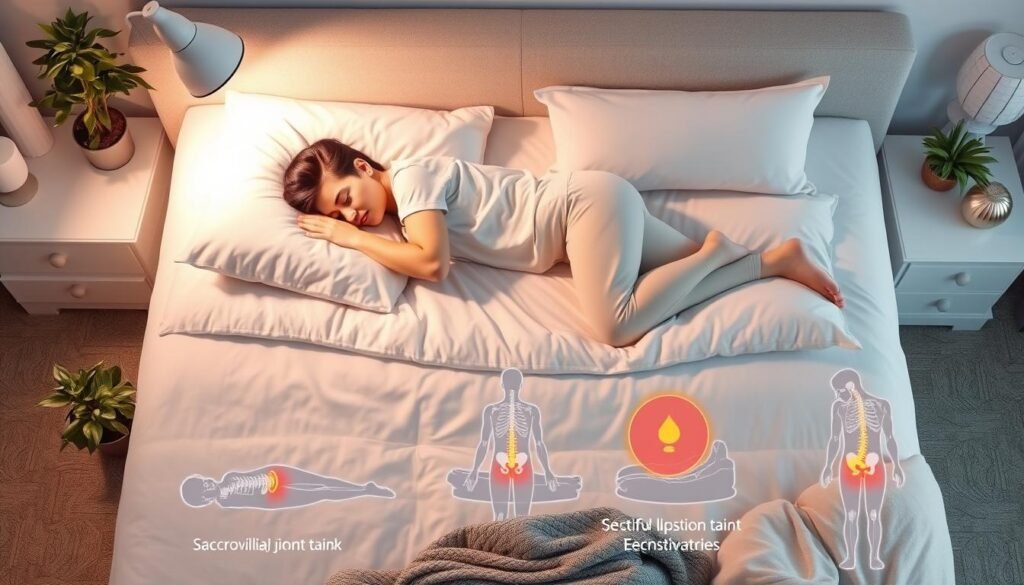
The sacroiliac joints are located on either side of the spine. They connect the sacrum (a triangular bone at the base of the spine) to the iliac bones (the large bones that make up the pelvis). These joints are surrounded by a complex network of ligaments and muscles. They help stabilize the pelvis and transfer weight from the upper body to the legs.
Sacroiliac joint pain can have various causes, both traumatic and atraumatic. Traumatic causes include pelvic ring fractures, soft tissue injuries, and indirect injuries from motor collisions3. Atraumatic causes include spondyloarthropathy, enthesopathy, and osteoarthritis3. High-intensity, repetitive, or torsional movements in sports like golf, bowling, or skating can also trigger SI pain3.
Sacroiliac joint pain may occur when the ligaments surrounding the joint become too loose or too tight4. Acute SI joint pain usually heals within several days to weeks, while chronic SI joint pain persists for more than three months4.
The most common symptoms of sacroiliac joint dysfunction include:
Diagnostic tests to identify SI joint pain include physical assessments, stress tests, and imaging studies such as X-rays, CT scans, and MRIs3. A diagnostic SI joint injection can also confirm the cause of pain. A decrease in pain level by more than 75% confirms sacroiliac joint involvement4.
| Rheumatic Inflammatory Diseases | Degenerative Joint Diseases |
|---|---|
| Ankylosing spondylitis | Osteoarthritis |
| Psoriatic arthritis | Degenerative sacroiliitis |
| Reactive arthritis | Sacroiliac joint dysfunction |
Many people with sacroiliac (SI) joint pain feel worse at night. This can disrupt their sleep and make mornings stiffer. About 15 to 30% of low back pain comes from the sacroiliac joint6. Knowing why pain gets worse at night can help find relief and better sleep.
Sitting or sleeping for 20 hours a day can make the SI joint stiffer and more painful7. When we stay still for too long, the muscles and ligaments around the joint tighten. This can cause dull pain in the lower back and upper buttocks7.
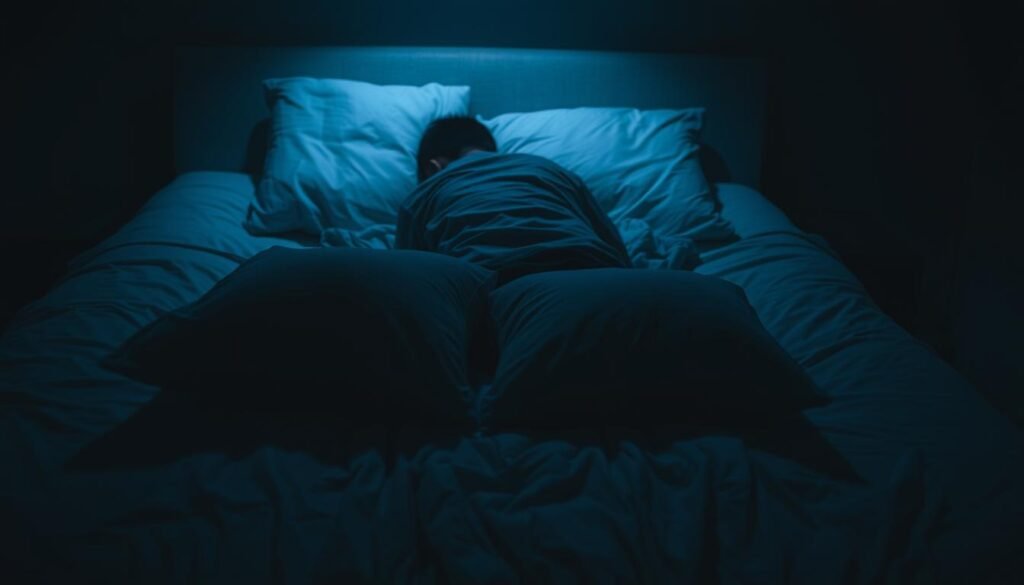
Patients often feel more pain when they move or change positions in bed because of SI joint issues6. Sudden movements can cause sharp pain in the SI joint. This pain can spread to the hips, groin, and upper thigh’s back side7.
Sleeping on the side of the affected SI joint can put more stress on it, making pain worse6. It’s important to be careful with sleep positions and movements to avoid straining the SI joint. Using a pillow between the legs when sleeping on the side can help keep the hips, pelvis, and spine aligned for comfort6. Also, many patients prefer a medium-firm or firmer mattress for SI joint pain6.
If you have persistent or severe SI joint pain at night, it might be a sign of spinal arthritis like ankylosing spondylitis. In such cases, seeing a doctor is key to get a proper diagnosis and treatment plan.
When you have sacroiliac joint pain, your sleep position matters a lot. Sleeping on the side of the painful joint can make pain worse. This can make it hard to sleep well. About 13% of people with chronic low back pain have sacroiliac joint dysfunction8.
Also, 15-30% of low back pain cases are due to SI joint injury8. To ease pain and help heal, it’s wise to avoid sleeping on the affected side.
Lying on your back with the painful side up is a good alternative. This reduces pressure on the joint and can ease pain. Use a supportive pillow under your knees to keep your spine and hips aligned right.
Half of people with SI joint pain can link it to a specific event, like a car accident or sports injury9.
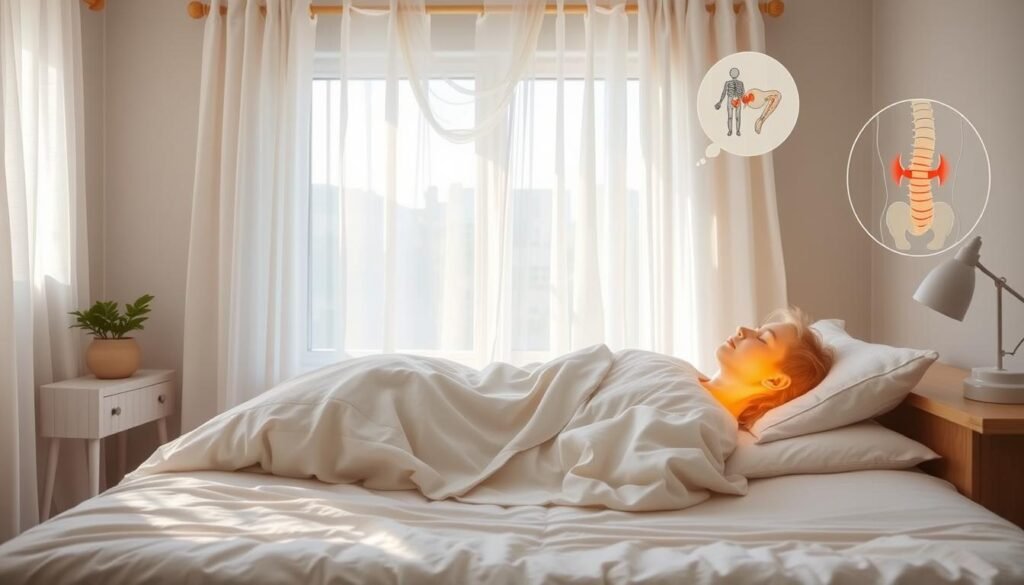
Lying on your back is another good option. It spreads your weight evenly and lessens pressure on the joint. Place a pillow under your knees to keep your spine and hips in line.
Factors that increase your risk of SI joint dysfunction include a shorter leg, abnormal walking, and scoliosis9.
If you must sleep on your side, choose the unaffected side and put a pillow between your legs. This keeps your spine and hips aligned, easing stress on the sacroiliac joint. SI joint pain usually affects one side more than the other9.
Using high-quality pillows and mattresses that support spinal alignment is key for managing SI joint pain at night8.
| Sleeping Position | Benefits |
|---|---|
| Affected Side Facing Up | Reduces pressure on painful joint |
| Lying on Back | Evenly distributes weight, minimizes joint pressure |
| Unaffected Side with Pillow Between Legs | Maintains spine and hip alignment, reduces joint stress |
Return the SI joint to its normal position and maintain alignment are typical goals of rehabilitation for SI joint pain.
By changing your sleep position and using supportive pillows, you can lessen sacroiliac joint pain and better your sleep. Teaching patients is key in SI joint treatment plans10.
Finding the right sleeping position can greatly help with sacroiliac joint pain. It’s important to ease pressure on the joints and keep the spine and hips aligned. Sleeping on your back with a pillow under your knees and side sleeping with a pillow between your legs are good options.
Sleeping on your back is often suggested for sacroiliac joint pain. It spreads your weight evenly and lessens stress on your spine and hips. Adding a pillow under your knees can tilt your pelvis back, easing joint pressure11.
This pillow also makes your sleep more relaxed. It helps your muscles relax and eases tension in your lower back.

Side sleepers with sacroiliac joint pain can find relief by sleeping on the unaffected side. A pillow between your knees and ankles aligns your hips and opens your hip joints11. This reduces strain on your sacroiliac joints and keeps your pelvis in a neutral position.
The pillow also keeps your spine aligned, reducing twisting that can worsen joint pain.
A pillow between the knees and ankles can align the hips while sleeping.
For side sleeping, use a firm pillow that still gives a bit. Place it between your knees and down to your ankles for all-night support.
| Sleeping Position | Pillow Placement | Benefits |
|---|---|---|
| Back Sleeping | Under Knees | Relieves pressure on SI joints, promotes neutral pelvic position |
| Side Sleeping | Between Legs | Aligns hips, opens hip angle, reduces strain on SI joints |
Finding the best sleeping position for sacroiliac joint pain may take some trying. Pay attention to your body and adjust as needed. The right position, along with a supportive mattress and pillows, can greatly improve your sleep and manage pain.
Using the right pillows can greatly help with sacroiliac joint pain. They provide support and keep the body aligned right. By placing pillows in key spots, we can ease pressure on the sacroiliac joints. This makes sleeping more comfortable12.
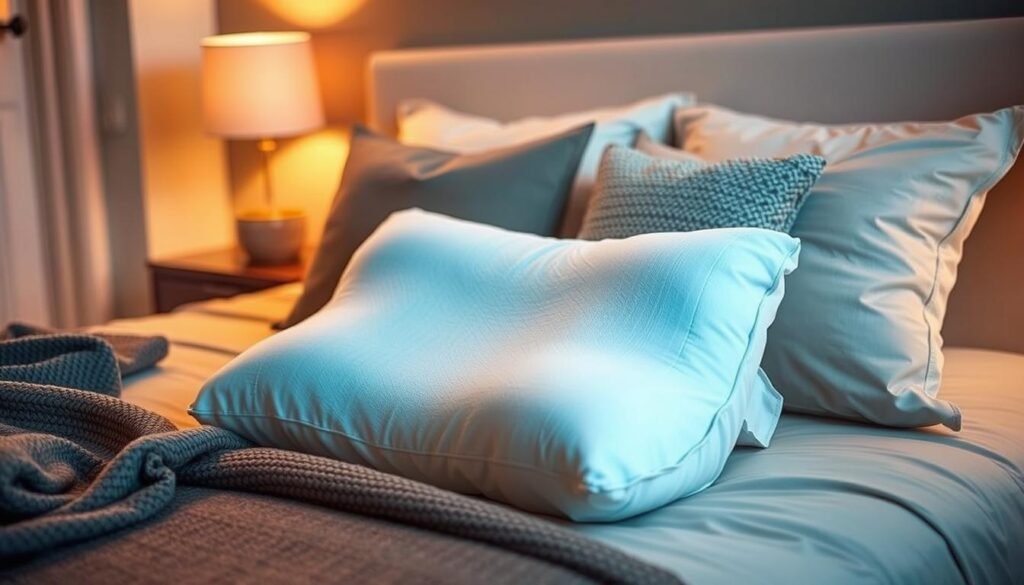
Back sleepers can benefit from a pillow under their knees. This keeps the spine’s natural curve and lessens sacroiliac joint strain12. Elevating the knees supports the lumbar area, improving alignment and possibly easing lower back pain12.
Side sleepers can also find relief with the right pillow placement. A pillow between the knees aligns the hips and eases lower back pressure12. This is especially good for those with sacroiliac joint pain, as it stabilizes the joints and keeps the spine neutral. Sleeping on the left side also boosts circulation, cuts acid reflux, and reduces snoring12.
Choosing the right head pillow is key for spinal alignment and less neck and back strain. A good head pillow should fit the neck’s natural shape, offering enough support without being too high or too low. Pick a pillow made for your sleep style for the best comfort and support.
Other aids can also help with sacroiliac joint pain. A lumbar pillow or a seat with lumbar support can align the pelvis and SI joints, easing pressure and pain. Wearing an SI brace or using kinesiotape can also stabilize the sacroiliac joints and aid in healing13.
| Sleeping Position | Pillow Placement | Benefits |
|---|---|---|
| Back Sleeping | Under the knees | Maintains natural spine curve, reduces SI joint strain |
| Side Sleeping | Between the knees | Aligns hips, reduces lower back pressure, improves circulation |
By adding these pillow strategies and aids to your sleep routine, you can ease sacroiliac joint pain and better your sleep. Remember, comfort is key, as we spend about 20 hours a day sitting or sleeping13. Small changes in your sleep setup can make a big difference in managing sacroiliac joint pain and boosting your overall health.
Finding the right mattress is key for managing sacroiliac joint pain at night. A mattress that supports well but isn’t too hard or soft is best. Medium-firm mattresses are often suggested because they offer the right mix of support and softness14.
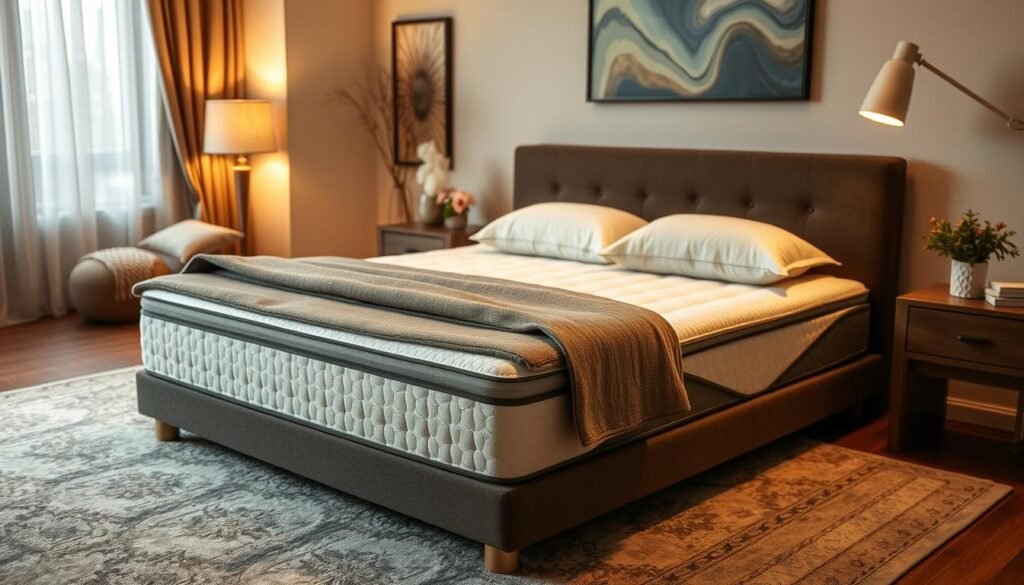
Look for a mattress that fits your body’s shape and keeps your spine straight. High-density foam or pocketed coil mattresses are great for support and less motion transfer14. A mattress that fits your body’s shape and keeps your spine straight is key for sacroiliac joint pain relief15.
Memory foam and hybrid mattresses are top choices for sacroiliac joint pain relief14. These mattresses are made to support your body fully and help you sleep without pain16. Different materials like memory foam, latex, and hybrids offer various benefits for comfort and support14.
| Mattress Type | Benefits for Sacroiliac Joint Pain |
|---|---|
| Memory Foam | Conforms to body shape, relieves pressure points |
| Hybrid | Combines support of coils with comfort of foam layers |
| Adjustable | Allows customization of sleeping position and support |
Getting advice from a healthcare professional is a good idea for finding the best mattress for you14. A quality mattress can greatly improve your sleep and help you wake up feeling better and without pain.
Getting a steady sleep schedule is key to managing sacroiliac joint pain. Going to bed and waking up at the same time every day helps our bodies get into a healthy rhythm. It’s also important to avoid napping during the day. Napping can mess up our sleep cycle and make it tough to sleep well at night.
Having a great bedroom environment is also crucial. Your bedroom should be cool, dark, and quiet. It should have a supportive mattress and pillow to keep your spine aligned. Research shows that sacroiliac joint pain affects 15% to 25% of people with low back pain17. Starting with simple changes like a better sleep routine can help ease this pain17.
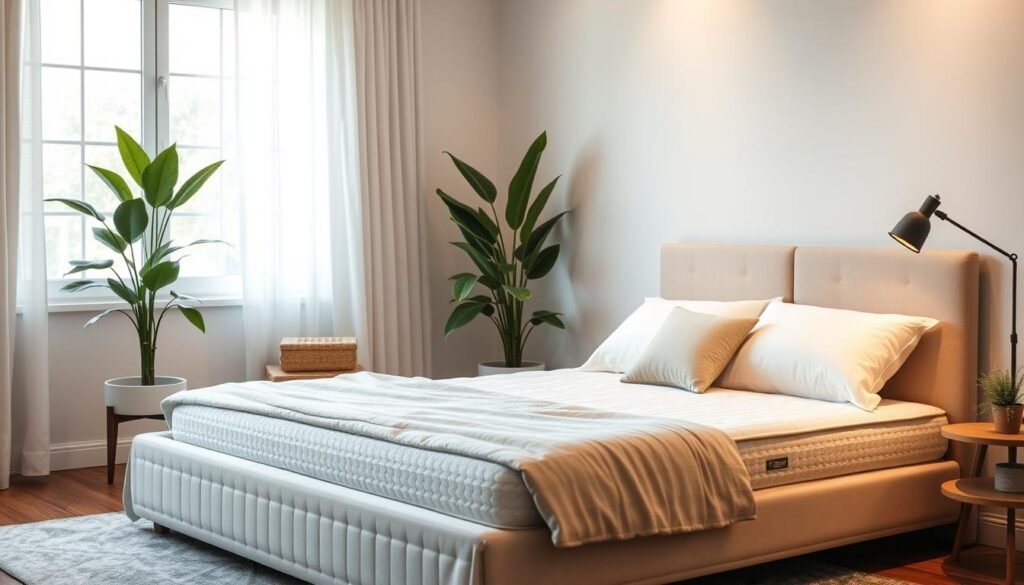
Try to avoid alcohol and caffeine before bed. These can mess with your sleep and make pain worse. Instead, have a warm, caffeine-free tea or try relaxation techniques like deep breathing or meditation to relax before bed.
“Sacroiliac joint dysfunction is reported to occur in 13% of individuals with chronic low back pain, and between 15% to 30% of cases of low back pain are attributed to sacroiliac joint injury.”18
Also, take a few minutes to stretch before bed. Gentle stretches for the hips, glutes, and lower back can help relax tense muscles and reduce sacroiliac joint pain. Try knee-to-chest stretches or lying spinal twists. By adding these simple habits to your bedtime routine, you can sleep better and wake up feeling better.
Doing specific exercises can ease pain from sacroiliac joint issues. SI joint problems can cause lower back and hip pain. They also make it hard to stand or sit for long, and hurt when bending or twisting19. Things like arthritis, pregnancy, and injuries can also cause these problems19.

Strengthening the transversus abdominis muscles is key for SI joint stability. Lie on your back with knees bent and feet flat. Pull your lower abs toward your spine while breathing normally. Hold for 10-30 seconds, then release and do it 10 times.
Stretching the hip flexors and piriformis can lessen SI joint tension. The Figure 4 stretch is great for these muscles. Here’s how to do it:
Using a hip flexor release tool or massage ball before stretching can make the hip flexor stretch and piriformis stretch more effective.
The article mentions 5 SI joint stretches for natural pain relief19. These exercises improve flexibility, reduce tension, and strengthen core muscles to ease SI joint pain19. For example, Downward Facing Dog Pose stretches the back, hamstrings, and spine while strengthening the legs, arms, shoulders, and abdomen19.
| Diagnosis | Characteristics |
|---|---|
| Hypermobility | Moving too much, often caused by weak ligaments, genetic factors, and over-strain |
| Hypomobility | Moving too little, causing stiffness and reduced range of motion |
| Sacroiliitis | Inflammation of one or both SI joints, associated with conditions like ankylosing spondylitis, psoriatic arthritis, or Crohn’s disease |
| SI Joint Arthritis | Typically occurs in older adults, causing pain and stiffness in the SI joints |
Sacroiliac Joint Dysfunction can be diagnosed as either moving too much (hypermobility) or too little (hypomobility), with hypermobility often caused by weak ligaments, genetic factors, and over-strain. Sacroiliitis, the inflammation of one or both SI joints, can be associated with inflammatory conditions such as ankylosing spondylitis, psoriatic arthritis, or Crohn’s disease. SI Joint Arthritis typically occurs in older adults, causing pain and stiffness in the SI joints20.
It is essential to consult a healthcare provider before starting any of the SI joint stretches to ensure safety and effectiveness in pain relief.
PainTEQ is introduced as a potential solution for treating SI joint pain, offering the LinQ SI Joint Stabilization System as an innovative procedure19. However, it is crucial to consult a healthcare provider before starting any of the SI joint stretches to ensure safety and effectiveness in pain relief19.
Managing sacroiliac joint pain can be done with several alternative treatments. These methods help restore joint mobility, reduce inflammation, and promote healing. They work well when used with proper sleeping positions.
Chiropractic manipulation, especially high-velocity low-amplitude manipulation, is effective for chronic pain. A skilled chiropractor applies a quick thrust to the joint to restore its motion. This helps address misalignments and restrictions, leading to reduced pain and improved function21.
Kinesiology taping offers support and pain relief for sacroiliac joint issues. It involves applying a thin, stretchy tape to stabilize joints, promote blood flow, and reduce pain. The tape can be worn for up to 3 days, providing continuous support even during sleep21.

While treatments like chiropractic manipulation and kinesiology taping can help, they might not work for everyone. Advanced cases may need a medical evaluation to find the best solution22. Orthopedic Care Centers with specialized surgeons, like Dr. Jeffrey Keen, can offer personalized solutions for sacroiliac joint pain22.
The table below compares the benefits of chiropractic manipulation and kinesiology taping for sacroiliac joint pain:
| Treatment | Benefits |
|---|---|
| Chiropractic Manipulation | Restores joint range of motion Addresses misalignments and restrictions Reduces pain and improves function |
| Kinesiology Taping | Stabilizes joints Promotes blood flow Reduces pain without limiting movement Can be worn for up to 3 days |
Using chiropractic manipulation and kinesiology taping in a treatment plan can help manage sacroiliac joint pain. This approach can improve quality of life for those affected.
If you’re dealing with ongoing or getting worse sacroiliac joint pain, you should see a doctor. This type of pain is behind 13% of chronic low back pain cases23. Also, 15-30% of low back pain comes from SI joint injuries23. Getting a proper medical diagnosis is key to figuring out what’s wrong and how to fix it.
If your sacroiliac joint pain keeps getting worse and messes with your daily life or sleep, you need to see a doctor. SI joint pain can feel like dull, aching, sharp, stabbing, or radiating pain24. It might also hurt when you sit, climb stairs, or lie on the affected side23.
If you see signs of infection like swelling, redness, or warmth around the sacroiliac joint, and you have a fever, get help right away. These signs could mean a serious problem that needs quick treatment.
If you have severe joint pain after a fall or injury, can’t put weight on the joint, or if it looks or feels off, go to emergency care. SI joint pain can come from things like pelvic ring fractures, soft tissue injuries, or injuries from car accidents23.
Getting help early and the right treatment can really help with sacroiliac joint pain. Don’t ignore it if it’s bad or keeps coming back. See a doctor for a correct diagnosis and a treatment plan that’s right for you.
Choosing the right sleeping position can help a lot with sacroiliac joint pain. Side sleeping with a supportive body pillow or back sleeping with a pillow under the knees can make a big difference. The Zonli Ultra Luxury Faux Fur Body Pillow is great for side sleepers, offering comfort and support25.
Getting the right pillow and mattress is also key. Plus, good nighttime habits can help reduce pain and improve sleep. These steps can make a big difference in how well you sleep.
Doing exercises for the muscles around the sacroiliac joint can also help. This includes the transversus abdominis, hip flexors, and piriformis. Chiropractic manipulation and kinesiology taping are other treatments that can offer relief.
These methods can help fix the root causes of SI joint pain. This is important because SI joint dysfunction affects 13-30% of people with chronic low back pain26. By tackling the problem from all angles, you can feel better and move more easily.
If your pain doesn’t get better or gets worse, you should see a doctor. They can check you out, do tests, and figure out what’s wrong. This is especially true if you think you might have an infection or a serious injury26.
Working with a healthcare team and following the best practices for sacroiliac joint pain can really help. This way, you can manage your symptoms and sleep better at night.
Sleeping on your back with a pillow under your knees can help. Or, sleep on your unaffected side with a pillow between your legs. Both support your spine and hips, easing joint pain.
Sacroiliac joint pain can get worse at night because of inactivity and stiffness. Turning in bed can also cause pain. Sometimes, it’s a sign of a condition like ankylosing spondylitis.
Using a lumbar pillow can help. For back sleepers, a pillow under the knees is good. Side sleepers should use a pillow between their legs. A supportive head pillow is also key for alignment.
A medium-firm mattress is best for sacroiliac joint pain. It should support without being too soft or firm. Memory foam or adjustable mattresses offer customized support and relief.
Exercises that strengthen the transversus abdominis muscles can help. Try drawing in your lower abdominal muscles while lying on your back. Stretches for the hip flexors and piriformis, like the Figure 4 stretch, can also help.
Chiropractic manipulation, especially high-velocity, low-amplitude thrusts, can help. Kinesiology taping supports the joint, promotes blood flow, and reduces pain without limiting movement.
See a doctor if your pain is persistent or gets worse. If pain affects sleep or daily activities, or if you have constant or recurrent pain, seek help. Also, get urgent care for signs of infection or severe pain after an injury.